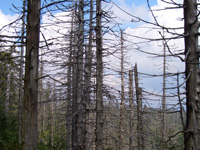The Forest is Our Friend - Right?
 Chicago, USA - Once considered the ’lungs of the planet’, Canada’s vast boreal forests are now being seen as a major contributor to climate change.
Chicago, USA - Once considered the ’lungs of the planet’, Canada’s vast boreal forests are now being seen as a major contributor to climate change.An article published recently in the Chicago Tribune notes that Canada’s forests, which account for more than 7% of Earth’s total forest lands, were always seen as able to suck up vast quantities of carbon dioxide from the atmosphere thereby ridding the world of harmful heat-trapping gases.
But scientists at the Canadian Forest Service (CFS) now believe that Canada’s forests, severely stressed from global warming, insect infestations and persistent fires, are pumping out more climate-changing carbon dioxide than they are sequestering.
Worse yet, notes the Chicago Tribune article, experts predict Canada’s forests will remain net carbon sources, as opposed to carbon storage “sinks,” until at least 2022, and possibly much longer.
“We are seeing a significant distortion of the natural trend,” said Werner Kurz, senior research scientist at the Canadian Forest Service and the leading expert on carbon cycles in the nation’s forests. “Since 1999, and especially in the last five years, the forests have shifted from being a carbon sink to a carbon source.”
Translation - Canada’s forests are no longer our friends.
Boreal forest is the most extensive forest type in Canada. Large amounts of carbon are stored in the trees and an even greater amount- 80% of the total carbon in the boreal forest - is actually in the soils, stored as dead organic matter that results from decomposition.
When trees are cut down to use them for forest products such as paper and lumber this releases large amounts of carbon dioxide into the atmosphere contributing to climate change. But 40-60% of the carbon in these trees remains in the forest in the form of roots, branches, and leaves left after the harvest which decompose over time, some of it quickly and some of it over many years.
“The forecast analysis prepared for the government … indicates there is a probability that forests would constitute a net source of greenhouse gas emissions,” a Canadian Environment Ministry spokesman told the Montreal Gazette.
Canadian officials also point out that rising temperatures are slowly drying out forest lands, leaving trees more susceptible to fires, which release huge amounts of carbon into the atmosphere, and to the spread of pest such as the mountain pine beetle, which has destroyed pine forests across British Columbia. More than 50,000 square miles of British Columbia’s pine forest have been stricken so far.
“That’s what’s causing some of our forests to switch from a carbon sink position to a source position,” said Jim Snetsinger, British Columbia’s chief forester. “Once those infested trees are killed by the pine beetle, they are no longer sequestering carbon-they are giving it off.”
Models show that Canada’s forests will stay stuck in a vicious global-warming cycle, both succumbing to the effects of climate change and, as they decay and release more carbon, helping to accelerate it.
While environmentalists contend that the extreme stresses on Canada’s forests means that logging ought to be sharply curtailed to preserve the remaining trees for as long as possible. Canadian Forest Service experts say reducing harvesting would have very little impact on carbon dioxide emissions because less than 0.5% of the managed forest is harvested in any given year in Canada and these harvested areas regenerate to become forests again.
In any year there is substantial new storage of carbon occurring in the areas previously harvested. The combination of harvest and re-growth along with the storage of carbon in long-lasting forest products means that our forest management practices do not result in substantial emissions, notes the CFS website.
Another argument against a logging moratorium is the fact that wood products are essential for construction, furniture and other uses and these would have to be replaced with other man-made materials, such as plastic, steel or concrete, which require burning more fossil fuels and adding more carbon emissions.
Some argue that more extensive harvesting of older forest stands, which are most vulnerable to insect infestations and have nearly reached their carbon-storage capacity, will enable replanting of younger trees which absorb more carbon during their growing years.
See also Business Report Planting Trees and Managing Soils to Sequester Carbon.
For More Information: Chicago Tribune
You can return to the main Market News page, or press the Back button on your browser.


